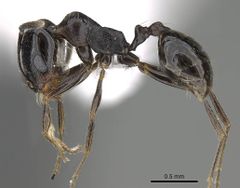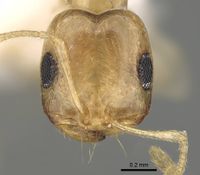Key to Arabian Trichomyrmex species
You may also be interested in
1
- Underside of head with abundant long ammochaete J-shaped hairs forming a distinct psammophore (Fig. 1A) . . . . . 2
- Underside of head with scattered short hairs or few long hairs but not forming a distinct psammophore (Fig. 1B) . . . . . 4
2
return to couplet #1
- Unicolorous black species. Eyes reniform in profile, with distinctly concave ventral margin and broadly convex dorsal margin. Propodeal dorsum making an obtuse angle with propodeal declivity in profile. Posterior margin of head strongly concave in full-face view (Saudi Arabia) . . . . . Trichomyrmex almosayari
- Bicoloured species. Head, mesosoma, petiole and appendages brown or reddish brown, gaster brown or blackish brown. Eyes nearly oval in profile (Fig. 1D). Propodeal dorsum making a continuous curve with propodeal declivity in profile (Fig. 1D). Posterior margin of head nearly straight or feebly concave in full-face view . . . . . 3
3
return to couplet #2
- Smaller species (TL 3.27, HL 0.88, HW 0.88, PW 0.45). Scapes distinctly longer; when laid back from their insertions scapes reach the posterior margin of the head (SI 82) (Fig. 1E). Posterior margin of head nearly straight or shallowly concave (Fig. 1E). Cephalic dorsum between frontal carinae and in front of eyes longitudinally rugulose with posterior half slightly shining (Fig. 1E) (Algeria, Saudi Arabia, United Arab Emirates) . . . . . Trichomyrmex chobauti
- Larger species (TL 4.06–4.50, HL 0.95–1.09, HW 1.00–1.15, PW 0.60–0.61). Scapes shorter; when laid back from their insertions scapes just reach level of posterior margin of eyes (SI 53–65) (Fig. 1F). Posterior margin of head shallowly but distinctly emarginated medially in full-face view (Fig. 1F). Cephalic dorsum distinctly finely and densely longitudinally costulate and completely dull (Fig. 1F) (Algeria, United Arab Emirates) . . . . . Trichomyrmex lameerei
4
return to couplet #1
- Propodeal spiracle vertically slit-shaped or elliptical (Fig. 2A). Anterior clypeal margin with a pair of well-developed strong teeth which overhang the mandibles, these teeth broadly separated by a distance greater than maximum width across frontal lobes (Fig. 2B) . . . . . 5
- Propodeal spiracle circular or subcircular (Fig. 2C). Anterior clypeal margin without teeth (Fig. 2D) . . . . . 6
5
return to couplet #4
- Promesonotum in profile distinctly convex (Fig. 2E). Propodeal dorsum about twice as long as declivity in profile (Fig. 2E). Propodeum, petiole and postpetiole irregularly rugulose (Fig. 2F) (Benin, Burkina Faso, Eritrea, Ethiopia, Ghana, Nigeria, Sudan, Tanzania, United Arab Emirates) . . . . . Trichomyrmex abyssinicus
- Promesonotum in profile flat (Fig. 3A). Propodeal dorsum as long as declivity in profile (Fig. 3A). Propodeum sides, petiole and postpetiole finely punctate-reticulate (Fig. 3A) (Armenia, Cyprus, Greece, Turkey, Jordan, Syria, United Arab Emirates) . . . . . Trichomyrmex perplexus
6
return to couplet #4
- Unicolorous yellow species. Propodeal dorsum densely punctulate-reticulate (Fig. 3B). Eyes conspicuously larger (EI 31–37) (Fig. 3C) (Saudi Arabia) . . . . . Trichomyrmex shakeri
- Unicolorous dark brown or reddish brown; or bicoloured species with at least gaster distinctly darker than rest of body. Propodeal dorsum finely transversely striolate or transversely rugulose (Fig. 3D). Eyes conspicuously smaller (EI 15–18) . . . . . 7
7
return to couplet #6
- Head and mesosoma yellow (India, Pantropical tramp species) . . . . . Trichomyrmex destructor
- Head and mesosoma brown or reddish brown . . . . . 8
8
return to couplet #7
- Posterior margin of head transversely striolate in dorsal view (Fig. 3E). Promesonotum in profile nearly flat or weakly convex (Fig. 3F). Propodeal dorsum in profile making a continuous curve with propodeal declivity. Transverse sculpture of propodeal dorsum fine and dense. Pilosity of mesosoma, petiole, postpetiole and gaster short, and weakly curved (India, North Africa, Middle East, Afrotropical, Indomalayan and Oriental regions) . . . . . Trichomyrmex mayri
- Posterior margin of head transversely smooth in dorsal view. Promesonotum in profile strongly convex (Fig. 4B). Propodeal dorsum in profile making a weak but distinct obtuse angle with propodeal declivity (Fig. 4B). Transverse sculpture of propodeal dorsum coarse and broadly spaced. Pilosity of mesosoma, petiole, postpetiole and gaster longer, and strongly curved (Fig. 4C) (Somalia, Afrotropical and Malagasy regions) . . . . . Trichomyrmex robustior
































